In just a few short weeks, Peter F. Hamilton’s The Abyss Beyond Dreams (surely a most perfect title) will be published by Tor UK! (The US edition is published by Del Rey.). I’m in the very fortunate position to have read it already and not only did I adore it, but it also reaffirmed all of the reasons why PFH proves himself, time after time, to be my favourite author.
Here are just ten of the reasons why—although, given enough time and internet paper, there would have been far more reasons than that. If you were to cut me in half, it’s quite possible you would see ‘PFH fangirl’ written across the section as if I were a big stick of moonrock.
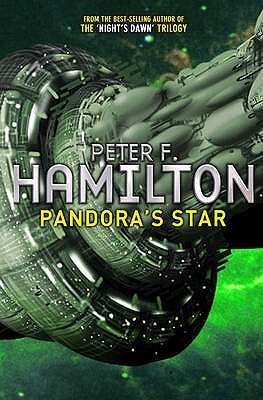 Pandora’s Star
Pandora’s Star
Pandora’s Star is my most loved novel. It was also the first book by Peter F. Hamilton I ever read and it is still my favourite, despite the stiff competition. It kept me spellbound for one glorious week and I will never forget, but will repeatedly revisit, its wonders. I will always remember Ozzie and Nigel appearing on Mars, by wormhole not by spaceship, unlike the poor flagplanting sods they met on the planet’s surface, and the mystery of what could possibly be hiding below the shield protecting (or imprisoning) the two Dyson planets. And then, when we find out… who’d have thought it?
Ozzie’s magical hunt for the answers to the universe takes him along the hidden and twisted paths of the singing silfen, a mystical quest that continues to enchant me, demonstrating how for me science fiction reaches its greatest heights when it pulls in all of the worlds around it, whatever their genre galaxy, and how its interludes are often as important as its ‘main’ storylines. Just think of the extraordinary extended account of the evolution and spread of the Prime race.
The people you meet
You’ll meet people (not all of them human) that you’ll care about within the pages of a Peter F. Hamilton novel. There’s the added benefit that some pop up time after time, such as detective Paula Myo a woman who has lived for far longer than she should but still remembers her purpose in life and sticks to it. Plus Nigel, co-inventor of the wormholes and one of the leading figures in The Abyss Beyond Dreams, travelling into the Void and, oh blimey, what he comes up against there… Others, though, have become so famous their names have now become expletives—looking at Ozzie here. Ozzie, who was once human but now seems eternal, has become godlike, a myth, such is his distance from real life. Others have become messiahs—Waterwalker Edeard. Not all of them are human—Qatux, the Raiel who feeds off human experience as if it were a life harming drug, Angela Tramelo, a woman who may or may not be a real life predatory beast, if only she could remember, and who could forget Capone in the Night’s Dawn trilogy? Not human, a monster really but there is so much that’s human about him, just as there is about many of the undead in that marvellous trilogy.
But the message is clear—avoid Quinn Dexter at all cost.
The places you visit
In a Peter F. Hamilton book, you’re never quite sure where you’ll end up—hopefully you’ll avoid the Void (unless you’re a pilgrim) or a ghost-filled space station drifting through non-space but if you’re lucky you might find a planet very similar to this one, albeit populated by merchants and farmers almost straight out of a Jane Austen novel, or an artificial spacefaring habitat with its own oceans, mountains and skyscrapers. Great North Road took us to two different worlds—one, Newcastle, was relatively familiar, but the other, St Libra, was something else entirely. This is an alien tropical hell; a planet that would eat you as soon as look at you and within it stalks a monster, one that wants nothing more than to feast on humans, one at a time, one after another, slowly, through the long night of terror. Moving between worlds doesn’t have to be by spaceship, you might travel by train through one of the great portals that transport people in vast numbers. It takes just a few minutes or, if needs me, it can take a lifetime.
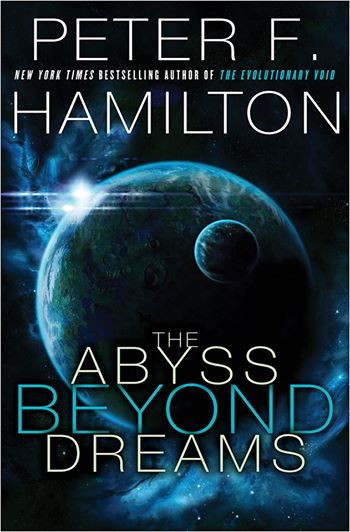 There is Wonder
There is Wonder
Wonder weaves its way through the novels of Peter F. Hamilton, lighting them up and filling them with joy. From the truly delightful scenes on the beach with the infant Raiel in the Night’s Dawn trilogy—the little alien jumps for joy when it sees its little human friend—to the absolutely gobsmacking moment in The Reality Dysfunction when an elderly starship is escorted by its fellow ships to its death in the atmosphere of Saturn. In its last dance, it mates with the other vessels, resulting in the birth of several infant vessels, each containing a human child. I can’t think of this without shivers tingling down my spine.![]()
Fantasy melds with science fiction most especially in the Void Trilogy and in The Abyss Beyond Dreams and it’s a ![]() marriage made in the heavens. Life goes on within the Void, in a time and realm far removed from ours but linked by dreams and intrepid exploration into the unknown. It’s a psychic world, watched over by Skylords, with animals in their eggs moulded by thought to take the form that their human owners wish. It’s compelling, and in The Abyss Beyond Dreams it reaches new wondrous heights, inspiring me to return to the Void trilogy.
marriage made in the heavens. Life goes on within the Void, in a time and realm far removed from ours but linked by dreams and intrepid exploration into the unknown. It’s a psychic world, watched over by Skylords, with animals in their eggs moulded by thought to take the form that their human owners wish. It’s compelling, and in The Abyss Beyond Dreams it reaches new wondrous heights, inspiring me to return to the Void trilogy.
And horror
Where there is wonder there is also horror and Peter F. Hamilton never shies from showing us the true terror of the other side. The undead return in The Night’s Dawn trilogy, driving out the souls of the bodies they possess with torture and screams. This raises huge and alarming questions in the minds of those at risk abut life after death and, for many of them, we watch it played out. Who could not fear the monster that shreds its way through the jungles of St Libra or slashes its victims into unrecognisable chunks of flesh? The description of the glutinous wall of trapped, frightened lost souls in the Night’s Dawn trilogy is not something I’ll forget in a hurry. And then there are the deaths that await those who are consumed by the alien eggs in The Abyss Beyond Dreams but even this pales beside the fate of one of the opening characters of the new novel. This is the stuff of nightmares.
Brickbooks
When a book’s as good as these are I want to keep reading and Peter F. Hamilton knows that and so he give us brickbooks. I’m a fast and hungry reader. It’s rare I’m able to spend a week with one novel rather than three but with Peter F. Hamilton’s novels I can luxuriate. And, in the case of the trilogies, you read one, there’s another waiting, with no danger of there being one of those difficult middle books.
Puts you in the thick of it
While to the uninitiated a monster brickbook might look intimidating, it doesn’t take long upon opening it to become completely engrossed. There’s plenty of science but the emphasis throughout is on the characters—their relationships, their journeys and their discoveries—and the mysteries of the worlds they inhabit. Peter F. Hamilton’s prose is deceptively light, enticing you in until you’re hooked and the portal has sealed behind you. These are exciting books but we’re in safe hands—Peter F. Hamilton takes me about as close as I ever want to get to planets inhabited by the soul eating possessed.
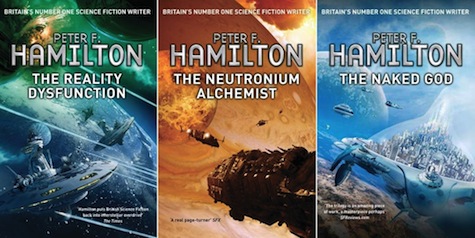
The Night’s Dawn trilogy
While Pandora’s Star is my favourite novel, Night’s Dawn is my most loved trilogy. These books form a monumental masterpiece, thousands of pages in length, and packed to the hilt with stories. It’s arguable that the divisions within it that split it into three are arbitrary, simply to save the reader the inconvenience of carrying around a volume as big as their car. Many lives and experiences can be found in these pages and many planets and habitats are encountered. I read the three books obsessively, finding great comfort in turning to books two and three. I will always remember courageous, resourceful Louise Kavanagh, one of Peter F. Hamilton’s finest creations, and the gradual takeover of her planet (and her family) by alien forces is done brilliantly. We see the universe through so many different eyes in Night’s Dawn, but it is always a pleasure to return to Louise and also to her fiance, Joshua, who pursues his own ambitious agenda, out there, exploring the mysteries of space, finding its very edges.
Keep the books, get rid of your furniture
More than one Peter F. Hamilton novel is currently holding up a lamp in my home. I live in a small flat but I’d prefer to give up furniture than Peter F. Hamilton’s books.
Well, he’s just a nice bloke, too!
Kate Atherton reviews books on her blog For Winter Nights.





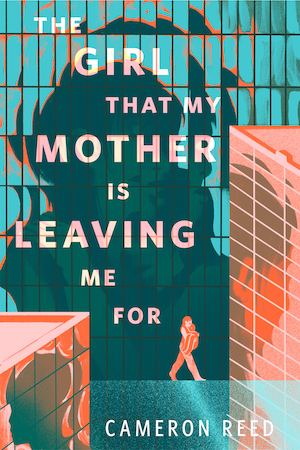




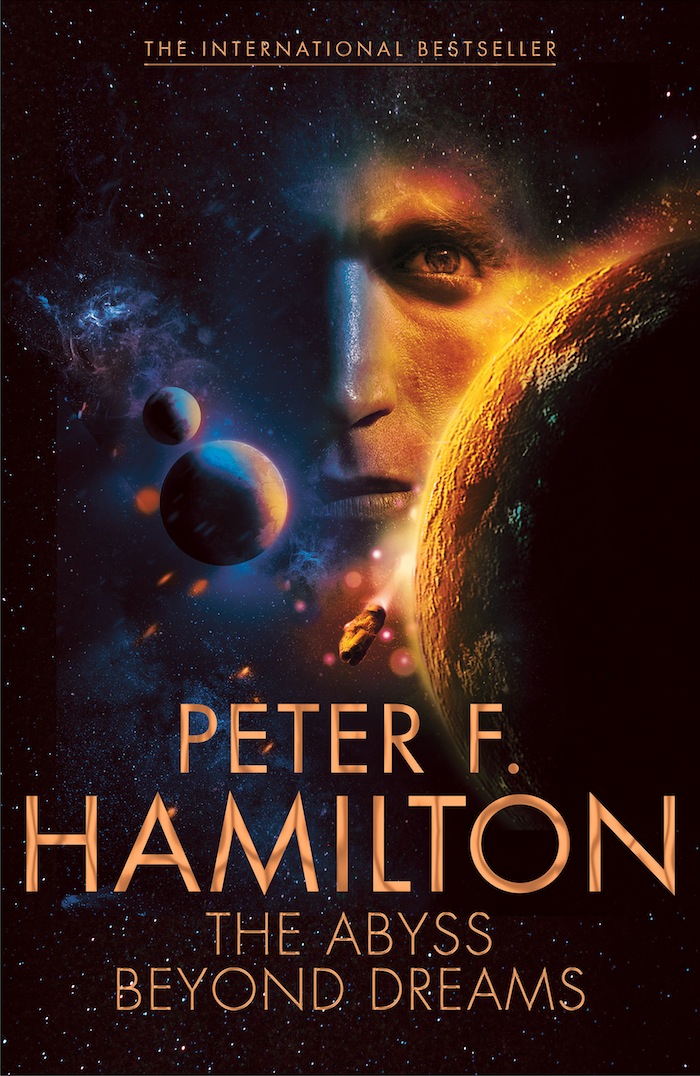
I’ve always had a strong fondness for the Greg Mandell books – they’ve had that nice combination of near future prescience combined with real human behaviour.
Plus it is nice to have properly UK based stories that aren’t London focussed, and the post broken state idea was well done.
It was also one of the first series I remember reading that dealt with living with severe climate change in a matter of fact way.
Having been a Arthur Clarke in terms of my sci-fi reads, and enjoying Hyperion (Simmons), Hamilton is one I have NOT read YET…… I keep almost buying a book of his, but never know where to start. I will also mention I could not get far into Blindsight (Watts), and abandoned it.
Any suggestions on where to start with him from those on here who have read his work? I really want to give him a try.
I will mention this – I like at least some “real” science in m sci-fi.
@2: I would recommend to start with Pandora’s Star and it’s sequel, Judas Unchained.
Depends what you like. The Mandell books are cyberpunk set in a near future dystopia, and are three linked stories, though some years apart. They feel almost like alternate history, so haven’t dated as bad as you might think.
Once you get past those though, you hit doorstopper syndrome, which is one of the biggest benefits of the ebook versions :)
For the space opera, I’d probably suggest Fallen Dragon or the Commonwealth pair of Pandora’s Star/Judas Unchained.
Both the Void and Nights Dawn trilogies are pretty dense works. Rewarding, but hard going initially. When The Reality Dysfunction first came out in hardcover, I remember ruining my wrists for a week from the strain of physically reading it :)
He varies between soft and hard SF, often during the course of a single work, but is always consistent within the mileiu. So a soft idea like planetary wormholes will be exploited to a hard SF point – eg spaceship technology lags behind as the wormholes render them mostly unnecessary.
It’s obvious who Nigel and Ozzie are, but they’re one hell of a reality distortion.
Peter Hamiltion rocks. I find most of his books are slow-starters but I’ve not read a bad novel or short story (and I think I’ve read them all). Definitely in my Top 3 sci-fi writers of all time. Science and spirituality blend in to one perfectly.
“Wonder” sums it up for me. Back when The Reality Dysfunction came out, it was one of the first times I experienced that real “sensawunda” since my early teens. I’ve read almost everything he’s written since then. I’m considering going back and re-reading all the Void books in preparation for the new one.
Thanks Mayhem. Another author I want to check out is Alastair Reynolds – again I haven’t read anything of his….yet. ;)
I think the thing scaring me away from Hamilton (and even Neal Stephenson) all the time, is the size of the books (1100 + pages). I did read King’s It, which clocks in at 1178 (I think), and it was good.
@8: Alastair Reynolds is wonderful. I’d suggest Pushing Ice or House of Suns first, since they are standalone stories.
As for PFH, I loved Pandora’s Star but was a bit burned out by the end of Judas Unchained. I liked Great North Road quite a bit, and have started the first of the Void trilogy, but put it down because of its slow start. I’ll finish it one of these days.
There are scenes in Pandora’s that stand out as some of the best SF ever written. I won’t give them away, though!
Night’s Dawn trilogy still unnerves me, many years after reading it. I wholeheartedly second the idea of not being on a planet inhabited by soul eating possessed!
@8: I wouldn’t neglect Reynolds’ shorter fiction: a good selection is found in Zima Blue and Other Stories, the book which (along with “Turquoise Days”) got me started on his work in the first place.
I’ll give you one reason to maybe not read his books: he has something of a fondness for deus ex machina, “and then a space wizard I never mentioned came and fixed everything” endings. Doesn’t ruin his work, but it can be mildly annoying.
@12 Steve; good point. I do like a lot of the big pictures of Hamilton’s work but sometimes the small details and the prose itself don’t live up to the flow of the work. I almost think they’d be better as movies (probably have to be a TV series or multiple movies).
Marvellous writer. Haven’t read most of his work, but I’m definitely going to make it my goal to do so.
For whom is this article written?
I’m new to discovering Pandora’s Star and Hamilton but in a past era I read Bear, Asimov, and Niven; I’m pleasantly optimistic.
Sadly this article name-drops Hamilton characters as if it is written for those already familiar wIth his books. It didn’t help me understand why I should or shouldn’t continue reading and eventually “love” Hamilton despite his info-dumps of prose.
Of course, I shall continue reading/listening and make my own determination.